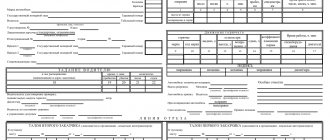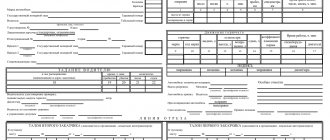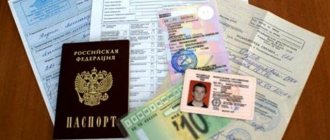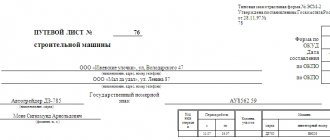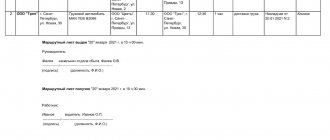New rules for issuing travel documents from 01/01/2021
The Ministry of Transport of the Russian Federation officially published order No. 368 dated September 11, 2020, registered by the Ministry of Justice, which updated the requirements for mandatory details and the procedure for filling out waybills. The document comes into force on 01/01/2021.
The appendix to the order contains updated rules for filling out waybills, replacing those approved by Order of the Ministry of Transport No. 152 of September 18, 2008. The mandatory details in the vouchers have been updated:
- name and number of the waybill;
- information about the validity period of the waybill;
- information about the owner (holder) of the vehicle;
- information about the vehicle;
- information about the driver;
- transportation information.
The list of mandatory details is supplemented with information about transportation, which should reflect information about the types of communication (city, suburb, intercity, international) and types of transportation (passengers, cargo, orders). In the “Information about the vehicle” detail, it is now mandatory to indicate its make.
A voucher should always be issued, and not only when leaving on a flight to transport cargo or passengers. Even an empty flight should be documented according to all the rules.
Separately, new requirements have been established for the waybill registration log. It is allowed to be maintained on paper or electronically. In the second case, all information entered into the journal is certified by an enhanced qualified electronic signature.
Form ESM-2: what you should pay attention to when filling out a voucher
The ESM-2 waybill can be issued to the driver (driver) of a vehicle for one working day or shift, a working week, or a calendar decade.
In a standardized form, a sample waybill for the ESM-2 construction vehicle contains the following data:
on the front side:
- installation – serial number of the waybill (put down manually and corresponds to the serial number of the record of issue in the “Journal of Waybills Registration”), date of issue of the document, name of the company executing the order,
- type, make and registration details of the vehicle,
- information about the person driving the vehicle - surname and initials,
- technical data - speedometer readings, a mark on the amount of fuel, information about the serviceability of the vehicle (information about fuel and lubricants is written out as completely as possible - the remaining amount in the tank at the start of work (at departure), the amount of fuel filled into the tank, its balance at the time of return of the vehicle is indicated),
- data on the work order - information about the cargo (name, quantity, class, etc.) and the point of receipt, or the facility where the work will be carried out, the mileage between the departure point and the facility, the number of trips made;
on the reverse side:
- information for calculations – start and end times of work, number of hours spent on work / cargo transportation,
- downtime information,
- the amount of payment for the work, the actual mileage of the special equipment within the order.
The reverse side of the waybill is filled out both by the contractor - on the left side of the form (the owner of the vehicle), and by the customer of the work - on the right side.
Information about downtime of special mechanisms due to the fault of the customer must be confirmed by him with a personal signature and stamp.
The mandatory information that a correctly completed waybill for the ESM-2 construction vehicle must contain also includes information about checking the vehicle by a mechanic before leaving for the line. The mechanic makes a note in the appropriate boxes about the pre-trip inspection, certifying the entry with a handwritten signature.
As a result, a correctly executed waybill must be certified by the following signatures:
- dispatcher;
- driver (driver);
- release mechanics;
- customer (foreman);
- accountant or standard setter;
- head of the enterprise.
What is the document for?
So-called travel vouchers are primary accounting documents, and maintaining travel vouchers at an enterprise is mandatory if organizations or individual entrepreneurs operate vehicles. At the same time, legal entities and individual entrepreneurs providing services for the transportation of goods or people are required to use unified forms of these documents.
Depending on the type of vehicle (VV) and the area of their application, different types of forms are used. Some of their types are designed for owners and tenants:
- passenger cars;
- trucks;
- special transport;
- passenger taxi;
- cargo taxi;
- public and non-public buses.
The forms necessary for entrepreneurs were approved more than twenty years ago by Decree of the State Statistics Committee No. 78 of November 28, 1997. They are still relevant, although over the years various changes have been made to the forms many times. In accordance with the order of the Ministry of Transport No. 476 dated November 7, 2017, additional information about the owner of the vehicle is indicated in the voucher: individual entrepreneurs - OGRIP, and organizations - OGRN.
Unified forms are not suitable for all organizations, and they are not required for everyone. Therefore, a legal entity (or individual entrepreneur) has the right to develop its own version, which takes into account all the mandatory details and necessary indicators. The use of your own modified form is indicated in the accounting policy of the organization, as defined in paragraph 4 of PBU 1/2008. Do not forget that the rules regulated by Article 9 of Federal Law No. 402-FZ of December 6, 2011 on accounting also apply to primary documents of strict reporting.
About waybills
Preparation of a waybill
Unfortunately, the waybill is issued only for one day or shift. You cannot issue a waybill for a week or a month.
Many inexperienced accountants believe that waybills can be compiled not only in a non-unified form, but also for a whole month at once. This popular position is based on numerous confusing letters from the Ministry of Finance of the Russian Federation. However, such a “homemade” waybill actually creates a number of obvious problems.
The first clarification on the possibility of not using the unified form of waybill is contained in the letter of the Ministry of Finance of Russia dated September 20, 2005 No. 03-03-04/1/214. And then this position was supported and developed in other letters from the financial department - dated February 20, 2006 No. 03-03-04/1/129 and dated April 7, 2006 No. 03-03-04/1/327.
However, not all accountants noticed that these explanations from officials only affect the waybill of a passenger car. The tax authorities also reacted with unforgivable inattention to the governing opinion. The Federal Tax Service of Russia for the city of Moscow in letters dated November 14, 2006 No. 20-12/100253 and dated June 19, 2006 No. 20-12/ [email protected] allows independently developed forms of waybills for all cars. That is, it interprets the opinion of the Ministry of Finance more broadly, going beyond its powers (letter of the Ministry of Finance of Russia dated May 6, 2005 No. 03-02-07/1-116).
The essence of the recommendations of official bodies is that it is not necessary to use the unified forms of waybills approved by Resolution of the State Statistics Committee of Russia dated November 28, 1997 No. 78 (hereinafter referred to as Resolution No. 78) for tax accounting purposes. Accountants can limit themselves to independently developed forms of primary accounting documents, approving them in the accounting policy of the enterprise.
note
Paragraph 15 of the instruction dated November 30, 1983 of the USSR Ministry of Finance No. 156, the USSR State Bank No. 30, the USSR Central Statistical Service No. 354/7, the RSFSR Ministry of Autotransport No. 10/998 states: “All organizations that have both their own and leased trucks are obliged to when the vehicle is released onto the line, issue the driver with a waybill in the appropriate form. Releasing a truck onto the line without a waybill in an approved form is strictly prohibited.”
“Homemade” waybills can be issued monthly. True, such “amateur activities” are allowed only to organizations that are not motor transport organizations.
The first law enforcement problem of “homemade” waybills is that the concept of motor transport organizations is not normatively defined. But the Charter of Motor Transport of the RSFSR (approved by Resolution of the Council of Ministers of the RSFSR dated January 8, 1969 No. 12) equates non-specialized enterprises with cars to motor transport. In addition, the unified forms indicate that waybills for all vehicles are standard interindustry forms.
The second problem is that the waybill is a document provided for by the Road Traffic Rules of the Russian Federation (approved by Decree of the Government of the Russian Federation of October 23, 1993 No. 1090, hereinafter referred to as the Traffic Regulations). And it is unlikely that the traffic police inspector will be satisfied with the abbreviated form developed by the enterprise. Agree, who on the highway will delve into the individual features of accounting policies.
On the road - only with a waybill
The desire of accountants to simplify the maintenance of waybills is explained by the fact that in small firms the responsibilities for filling out these forms fall on their shoulders. Well, Resolution No. 78 states that the waybill is issued by the dispatcher or an authorized person.
This means that the corresponding powers of the accountant must be approved by the administrative document of the organization. However, we must not forget that the purpose of the waybill is not limited to accounting for fuel consumption. After registering the waybills in the logbook (according to the unified form No.), it is issued to the driver against signature and accompanies him on the trip.
However, we must not forget that the purpose of the waybill is not limited to accounting for fuel consumption. After registering the waybills in the logbook (according to the unified form No.), it is issued to the driver against signature and accompanies him on the trip.
In addition to tax inspectors, traffic police inspectors are interested in waybills. According to paragraph 2.1.1 of the traffic rules, the driver is required to have a waybill with him and hand it over to police officers for verification upon their request.
True, the traffic rules contain a vague clause: the sheet is required “in specified cases.” And which ones exactly? First of all, a waybill is needed if the driver does not have a power of attorney to drive a vehicle. This means that when operating a passenger car under a power of attorney from an organization, you can indeed do without a waybill on the road. But a power of attorney will not replace a homemade “accounting” waybill. And then the driver faces an administrative fine under Article 12.3 of the Code of Administrative Offenses of the Russian Federation in the amount of 500 rubles.
But for cargo transportation, a unified waybill is indispensable. Paragraph 2.1.1 of the traffic rules states that the driver, in cases expressly provided for by current legislation, must have a waybill and hand it over for verification to employees of the Federal Service for Supervision of Transport.
The obligatory nature of a waybill when transporting goods of a commercial nature is established by paragraphs 47 and 50 of the Charter of Road Transport of the RSFSR. In this case, uniform forms of waybills are used and general rules for filling them out apply, but not the options approved by the head of the company.
Do you need to do double work?
The Russian Ministry of Finance unequivocally answered the question about the use of homemade monthly travel vouchers in a letter dated November 15, 2005 No. 03-03-04/1/363. They are allowed for a passenger car driven by an employee under a power of attorney and not transporting goods or passengers. Moreover, such sheets are intended to confirm fuel expenses for income tax purposes. And there are no grounds for using these documents outside of this specific situation.
Please note that Resolution No. 78 requires that truck waybills be stored together with waybills so that they can be checked at the same time. The numbers of shipping documents are entered in the waybill according to form No. 4-p. We must also not forget that the waybills keep records of the driver’s work. This means that they may be subject to inspection by the labor inspectorate.
Well, no one has canceled the requirement to undergo pre-trip medical examinations for drivers (clause 1 of article 20 and clause 1 of article 23 of the Federal Law of December 10, 1995 No. 196-FZ). According to the letter of the Ministry of Health of Russia dated August 21, 2005 No. 2510/9468-03-32, drivers undergo a medical examination with presentation of a waybill before each trip, that is, daily.
As a result, we see that a “homemade” waybill does not exhaust the variety of situations related to the operation of vehicles. And the accountant’s thoughtless desire to “simplify” unified forms can not only result in useless double work, but also entail financial sanctions.
Waybill form for 2021
A vehicle waybill is required when leaving any vehicle for work purposes, regardless of whether it is the organization’s own car or a rented one. Strict requirements for filling out this primary document are established not only for motor transport companies, but also for all others; it is a document of strict accountability, therefore it must contain mandatory details.
In 2018–2019 There is more such information - officials have added the obligation to indicate information about the driver undergoing pre-trip control of the technical condition of the car. In addition, the mandatory round stamp on the issued form was abolished.
By Order of the Ministry of Transport No. 467 of December 21, 2018, several important amendments were made to waybills from March 1, 2019:
- There are more mandatory details. Now entrepreneurs should enter odometer readings when leaving a vehicle from a parking lot (parking area).
- Dispatchers need to record the date (day, month, year) and time (hours, minutes) of the vehicle leaving the parking lot and entering it.
- The maximum period for which a voucher is issued has changed. At the beginning of 2021, once executed, the document was valid for one month. Now you can’t do this: the paper is issued for one working day or one working shift. If during this time the driver makes several flights, the rules allow the issuance of one waybill before the start of the first flight. It is allowed to close it upon the driver’s return to the parking lot.
- In situations where several drivers drive one vehicle, a personal ticket is issued for each of them. But when leaving, a mark on technical condition control is placed only in the document of the driver who was the first to leave the parking lot.
- We were allowed to carry out technical inspection of the vehicle either before a shift or before a flight (depending on the situation).
- The health care provider's stamp has become optional. This does not mean that the need to undergo a medical examination has been abolished, but the medical worker now does not have to confirm it with a stamp. He has the right to write that the driver has passed the inspection, indicate the date and time of the inspection, and sign. If the organization has a stamp, you can continue to use it. But due to the lack of an imprint on the waybill, they will no longer be able to punish you.
So, taking into account the amendments, new waybills for 2021 must include the following information:
- name and number of the document itself;
- information about the car owner;
- period of validity (period - one or several days) during which the waybill is allowed to be used, in the format “day, month, year”;
- information about the vehicle driver: full name, date and time of pre-trip and post-trip medical examination;
- information about the vehicle: type and model, including trailer, if any;
- registration number;
- odometer reading;
- date and time of departure and arrival to the parking lot;
- data on passing technical inspection before the flight (shift).
If a unified form is not suitable for an organization, its own form of waybill for a passenger car or other vehicle is developed, but taking into account all the mandatory details and necessary indicators. The use of the new form must be indicated in the organization’s accounting policies, as defined in paragraph 4 of PBU 1/2008. Do not forget that the rules regulated by Article 9 of Federal Law No. 402-FZ of December 6, 2011 on accounting also apply to primary documents of strict reporting.
The document is certified by the signature of the dispatcher who issued it and the head of the organization. The seal is affixed only by those organizations that use it in accordance with the charter. The form is prepared in one copy and given to the driver. After this, the document is returned to the authorized person for signature, in this case it is considered closed and goes to the accounting department. From this point on, you need to find out what the waybills are for.
Instructions from ConsultantPlus experts will help you correctly fill out waybills for cars and trucks. Use it for free by accessing the link below.
Sample of an individual entrepreneur's waybill for a passenger car
Example 1. The owner of a car is an individual entrepreneur. The waybill is issued for 1 day. In this case, technical control is carried out by a separate employee, and a medical examination is carried out by a medical worker.
An example of a waybill for a passenger car
Click on the picture to enlarge.
Who needs waybills and why?
Waybills are necessary for organizations to control the movement of vehicles, calculate wages for drivers, record fuel consumption, calculate depreciation on a vehicle, and account for total transport costs. In addition, if a driver in a company vehicle is stopped by a traffic police inspector to check his documents, this document confirms:
- validity of the flight;
- legality of transportation of cargo and passengers;
- good condition of the vehicle;
- the driver's right to drive the vehicle.
Article 12.3 of the Code of Administrative Offenses of the Russian Federation (Part 2) provides for a fine of 500 rubles for the absence of a waybill in the hands of the driver, when it is obligatory.
Responsibility for the absence of a waybill
The legislation of the Russian Federation does not allow driving a passenger vehicle without a permit.
For leaving without this form, a fine of 500 rubles is imposed. Sometimes you can limit yourself to a warning. Also, a driver may be subject to an administrative fine for filling out a ticket incorrectly. The legislation of the Russian Federation regulates the following fines:
- If the driver does not have a vehicle travel form, he will be fined 500 rubles or given a warning.
- If an official of the institution does not have a vehicle travel form, the fine is equal to 20 thousand rubles.
- For an institution, such a fine can be imposed up to 100,000 rubles.
- In some circumstances, all penalties may be imposed at the same time.
- The individual entrepreneur is fully responsible for this violation, even if he is not a legal entity. face. The fine for traveling without a voucher for an individual entrepreneur can reach up to 100,000 rubles.
Filling rules
The procedure for issuing waybills is established by Order of the Ministry of Transport No. 152 dated September 18, 2008. Waybills are taken into account in a special journal. Let’s take a closer look at what changes occurred in waybills in 2020 and how to draw up this document so that the inspectors from the tax authorities and the traffic police, who most often look at this document, do not have any questions.
Filling out this form in motor transport organizations is carried out by dispatchers, and in other companies - by an employee authorized to release cars for a trip. Such responsibilities are established by order of the head of the organization, since the one who fills out the document is responsible for errors made in it. Sometimes the drivers themselves do the paperwork. But as a general rule, drivers are required to fill out only their part of the document - record data on the car’s mileage in accordance with the indicators of the instruments in the car.
A voucher is issued only for one flight, one working day or shift. The unified form provides the opportunity to extend the validity of this document, since various situations can happen to a car during a trip, and driving without a waybill is a violation.
The waybill has several different forms depending on the type of vehicle. These forms differ in content and requirements for completion. We have collected them in a table so that each organization can easily navigate and choose the one they need.
| Unified waybill form | Who fills it out and how? |
| Form No. 3 for passenger cars | It is allowed to be used for registration of passenger vehicle flights both in specialized organizations and in ordinary companies. Features of filling out this form are given in Rosstat letter No. ИУ-09-22/257 dated 02/03/2005. |
| Form No. 4-c for trucks with piecework wages for drivers | The form is intended for motor transport companies engaged in cargo transportation. It contains columns for marks by representatives of the customer of the cargo. A new document is issued only after the driver has submitted the previous one to the accounting department. The form contains a tear-off coupon on the basis of which the salary is calculated. In form No. 4-p it is mandatory to indicate the numbers of waybills for the transported cargo. Such waybills should be stored together with transport documents. This form is valid for two flights within one business day. The waybill contains tear-off counterfoils, which are filled out by the vehicle owner for each flight. They are needed for further presentation of the invoice to the flight customer. |
| Form No. 4-p for freight transport with time-based wages for drivers | |
| Form No. 3-special for special vehicles (truck cranes, cement trucks, garbage trucks, fuel tanks, concrete mixers, etc.) | |
| Form No. 4 for passenger taxi | The form has a field for recording taximeter readings. Such a waybill is issued for the driver for only one shift, after which he submits it to the dispatcher. |
| Form No. 6 - bus waybill | Form for carrying out bus routes on city routes. It contains a column about pre-trip medical monitoring of the driver’s condition. |
If such waybills are suitable for the organization, download the forms directly from the links in the table from the relevant resolutions. Each registration document must be stamped with the stamp of the organization that owns or rents the vehicle in order for it to have legal force. In addition, it is necessary to indicate the time of departure from the garage and the exact time of return of the car to its place. Please take into account other requirements for their design.
In particular, both when the vehicle leaves the garage and after it returns to the garage, the records are checked for compliance with the indicators of the instruments in the car, such as the fuel gauge, odometer, etc. The technical condition of the vehicle must be endorsed by an authorized employee, for example, an organization mechanic. The data on the pre-trip medical examination must be filled out by a health worker indicating the date. The record must indicate that the driver “passed a pre-trip medical examination and was cleared to perform work duties.” If necessary, a note about the medical examination after the flight is placed.
Sometimes a special program is used to fill out vouchers. It allows you to hide unnecessary areas of a document, determine exactly how long the journey took, and put an exact number on each document. The announcement of the use of the program must be made to all dispatchers so that vouchers are issued in the same way. In addition, this will make life easier for drivers, who will be able to take into account every ruble spent on the road and display the exact balances. The absence of such a program is not a violation, since new forms are not prohibited from being filled out manually.
Who signs the ticket?
The form of the waybill for a special vehicle is considered to be filled out incorrectly if it does not bear the signatures of the responsible persons. They are installed after checking the driver’s health and inspecting the technical condition of the special vehicle. The voucher must be endorsed by:
- The paramedic who performs the pre-trip medical examination decides that the driver’s health condition allows him to drive the vehicle and that he is not under the influence of psychotropic substances or alcohol. A breathalyzer is used to check this.
- The mechanic carries out a technical inspection of the car and makes a decision regarding the possibility of releasing it on a trip, records the standard and actual amount of fuel used in the waybill for a special car, Form 3.
- The driver must sign for accepting and returning the car in working condition.
The tear-off coupon is filled out by the carrier company. It is intended to issue an invoice to the customer. It contains general information about the waybill (number, date of preparation, details of the organization, information about the car). Here is a detailed list of services provided by the carrier and the amount to be paid. The taxi driver signs the tear-off coupon. Used waybills are closed, information about this is entered into a special journal. According to the law, these documents must be stored at the enterprise for 5 years.
Sample filling
Let us consider in detail how to fill out each field using the example of form No. 3 (for a passenger car) for an individual entrepreneur. The sample, taking into account the latest changes, was prepared using the commercial version of ConsultantPlus.
IMPORTANT!
Organizations and individual entrepreneurs have the right to change the sequence of filling out the waybill. The main thing is that the content of the columns complies with the requirements established by the Ministry of Transport.
Let's start by indicating the series, number and validity period of the document. The series is an optional element, so it is sometimes missing. As for numbers, they are assigned to waybills in accordance with the approved numbering.
The validity period is determined depending on the situation. In our example, the document was issued for one shift.
The next section is for information about the owner or lessee of the vehicle.
Legal entities enter:
- Name;
- organizational and legal form;
- location address;
- contact number;
- OGRN.
IP indicate:
- Full name (patronymic if available);
- mailing address;
- contact number;
- OGRIP.
Information about the vehicle itself must be indicated as stated in the documentation. When filling out you must write:
- car make (can be in Latin or Cyrillic);
- number received during state registration;
- parking number, if available, if not, the field is skipped, this is not a violation.
The next large section is necessary to indicate who is driving the vehicle. The driver must be reported as follows:
- Full name (patronymic if available);
- Personnel Number;
- data from the driver's license (number, category or class).
Admission of a vehicle is not permitted without monitoring the technical condition of the vehicle and a medical examination. The corresponding marks are placed on the waybill indicating the specific travel time. The specified data is confirmed by authorized persons.
But there is one caveat: individual entrepreneurs operating exclusively passenger cars have the right not to conduct a pre-trip check of the technical condition of the vehicle. The rest are required to do this, so for most motor transport enterprises, technicians’ marks on waybills are mandatory.
Please note that the organization may not have its own medical worker and/or mechanic. In this case, to organize medical examinations and technical control, they either hire part-time workers or outsource this work.
Immediately before departure, the waybill must indicate the meter readings (integer numbers only) and the time they were taken. Next, you should enter data about what fuel was issued, in what quantity (if fuel is provided). All data is confirmed by the signature of the employee himself.
Many people have questions about what data to write down in the “Driver Tasks” section. If we are talking about a passenger car, then in the waybill issued for it they write at whose disposal the vehicle is being transferred. On forms for trucks it is allowed to write the person who ordered the transportation, and on forms for buses - the destination.
The driver is prohibited from changing the task. This can only be done by an authorized person of the owner or lessee of the vehicle, who acts as a representative of the employer. If the vehicle is used for special purposes, for example by law enforcement officers or road services, a note about this is placed on the waybill.
When the vehicle leaves the parking lot (garage), the dispatcher must record the time. In the future, this data is important for calculating time worked and, of course, wages.
Upon return, the travel voucher records the time of arrival, odometer readings, and information about the movement of fuel. Data on fuel consumption rates are taken from the Ministry of Transport order No. AM-23-r dated March 14, 2008, which approved fuel and lubricant consumption rates for road transport.
All data is confirmed by the signatures of authorized employees of the motor transport company.
If there were any delays along the way, the driver records this in a special section. Some people recommend indicating lunch time in this field.
The reverse side consists of a table and a few more lines. The table is filled out by the driver, entering the number of trips - one or several. He should write the destination and time of departure and arrival. If we are talking about a car that has been transferred to a private person, he is obliged to confirm the driver’s records.
The last section is the result of the vehicle's work per shift and payroll calculation. It is filled out to calculate wages. If the driver receives money based on the distance traveled, only 2 fields are filled in: “traveled, km” and “per kilometer, rub. cop." If the payment is time-based, fill out two other fields: “total in work order, hours” and “per hours, rub. cop." It is permissible to fill in all lines if necessary.
As a rule, this part is filled out in the accounting department, since only accountants are responsible for calculating and issuing wages to employees.
Responsibility for errors
Responsibility for the correct execution of documents rests personally with the head of the organization and authorized persons who are responsible for the operation of the vehicle. Those who sign the form are responsible for the accuracy of the data they certified. If, during an inspection, representatives of the Federal Tax Service reveal violations in filling out the waybill, they have the right to exclude fuel and lubricants written off on it from expenses for profit tax purposes. Then the organization will have to pay additional tax, fines and penalties assigned by inspectors.
What to write in a task for a driver
An example of filling out a waybill for a passenger car
is available. Here you need to indicate which organization the car is leaving from.
Submission address . The address where the car leaves from.
Time of leaving the garage, hours, minutes . You must specify the date and time.
Dispatcher-contractor . Full name and signature of the dispatcher-contractor confirming the departure and return of the car to the garage.
Time to return to the garage . The time when the car returned to the garage is indicated. The date and time are indicated.
Delays, waiting, delays on the way, visits to the garage and other marks. Indicated if there were corresponding delays, waits, etc. You also need to indicate the driver's lunch time.
The car was handed over . Driver. Signature and transcript. All clear.
Below is the print location.
